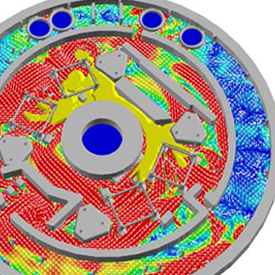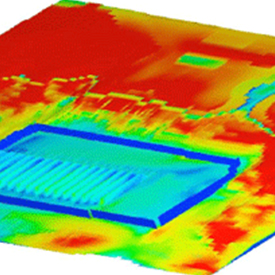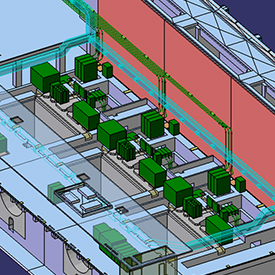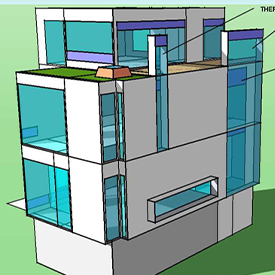
- Fuel or cargo sloshing inside containers on the high seas
- Wave effects on offshore platforms
- Performance optimization for separation devices undergoing 6 DOF motion
- Wave energy capture devices
Oil & Gas Separators
- Develop vessel inlet configurations to improve uniformity of gas and liquid flows and avoid mixing of oil & water due to wave-induced sloshing
- Determine the influence of internal equipment on hydraulic efficiency and separation performance
- Gauge the effects of changes in operating conditions
- Accurately model small-scale phenomena (multi-phase flows, drops, particles, bubbles)
Production Pipes
During the cleanup process in production pipes, dense particles may settle even if fluid is flowing upward. Devices can be designed to catch settling particles. A “bucket” centered in the pipe is one such potential device. Due to flow displacement, the upstream velocities outside the bucket are above settling velocities for high-density particles, corralling them inside the bucket. With the design shown, the upward fluid velocities around the bucket are higher than the particle-settling velocity. This makes it impossible for the particles to escape thorough the gap between the bucket and the pipe wall. Thus, none of the simulated particles passed the bucket to settle below.
Modeling Wave Energy Devices
Point Absorber Devices
This simulation shows a point absorber device with a buoyant spherical structure on top, moving up and down with the crests and troughs of the incoming waves. FLOW-3D’s moving objects model is used to allow coupled motion in the z-direction while restricting movement in the x or y directions. Stokes type waves were used with an amplitude of 5 m and wavelength of 100 m. The RNG model was used to capture the turbulence caused when the waves interact with the point absorber device. As expected, a lot of turbulence kinetic energy is generated near the device. The plot shows an irregular cyclic motion of the center of mass because of the evolution of complex velocity fields near the device due to turbulence.
Multi-Flap, Bottom-Hinged Wave Energy Converter
An oscillating flap extracts energy from the waves of the ocean and converts it into mechanical energy. The arm oscillates as a pendulum mounted on a pivoted joint in response to the water waves. Flaps can be organized into an array creating a multi-flap wave energy converter. An array of 3 flaps is simulated in the CFD simulation shown on the top right. All the flaps are hinged to the bottom and are 15m wide x 10m high x 2m thick. The array is operating in a 4m amplitude wave with a frequency of 10s at a depth of 30m. The simulation shows a complex velocity iso-surface along the central plane which is crucial in studying the effect of one flap on other flaps within an array. While the 3 flaps start off with similar dynamic motions, soon the interacting effect of the flaps renders their motion out of phase. A similar flap energy converter is shown on the bottom right. In this simulation, the flap submerges completely into water at its lowest point. Such energy converters are called Surface Piercing flap energy converters. Both of these simulation examples were provided by Minerva Dynamics.
Oscillating Water Column
An oscillating water column is a partially-submerged, hollow structure. It is open to the sea below the water line, enclosing a column of air on top of a column of water. Waves cause the water column to rise and fall, which in turn compresses and decompresses the air column. This trapped air is allowed to flow to and from the atmosphere via a turbine, which usually has the ability to rotate regardless of the direction of the airflow. The rotation of the turbine is used to generate electricity.
The CFD simulations to the right show oscillating water columns. Only the part where the water column rises and falls in the hollow structure is modeled in order to highlight the physics captured by FLOW-3D. The simulations convey the similar results except for a different choice of wave generation. The simulation on the left uses a wave type boundary condition, while the one on the right uses the Moving Objects model to generate a moving plunger that in turn produces waves – as done in the lab. A pressure plot in the hollow structure is shown for each simulation. It is important to know how much pressure is generated in the chamber, because eventually based on that pressure the turbine is set into rotational motion.




